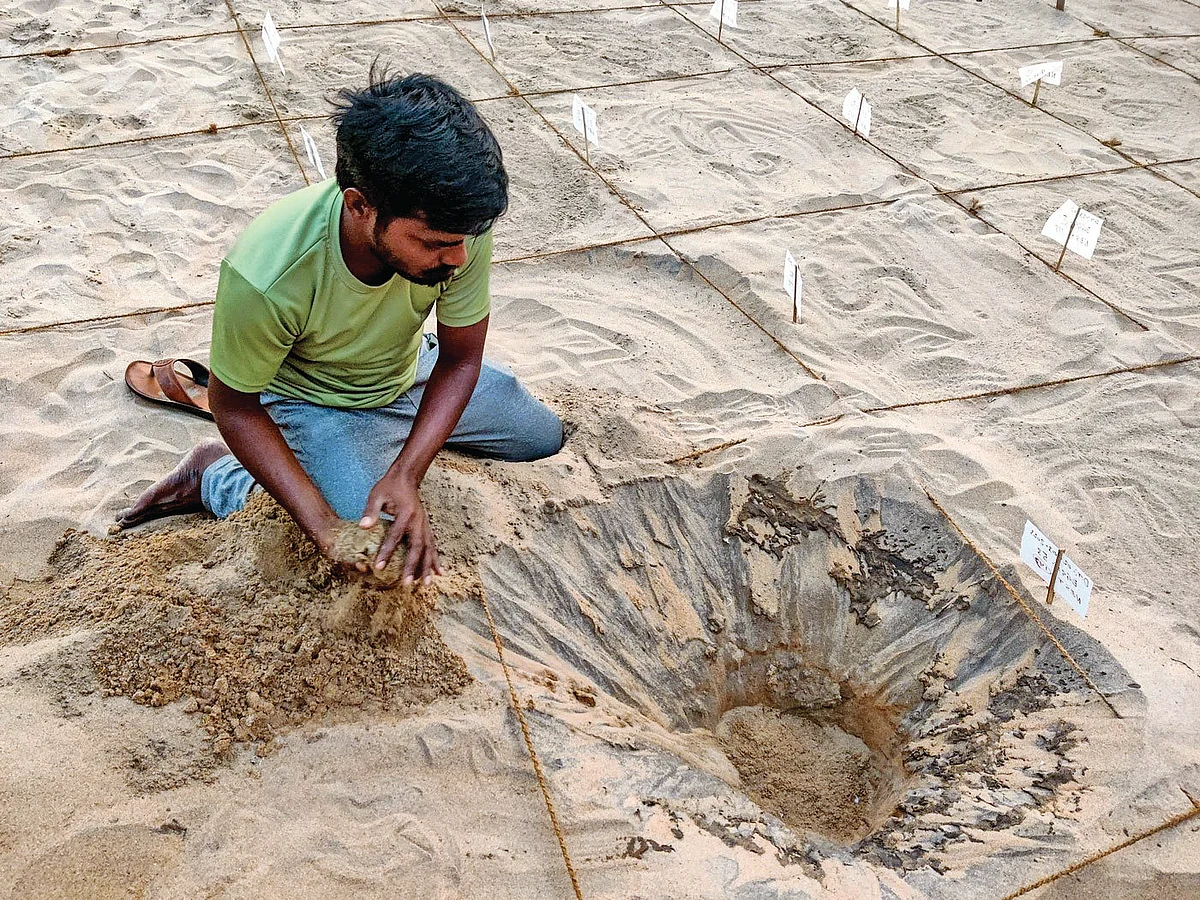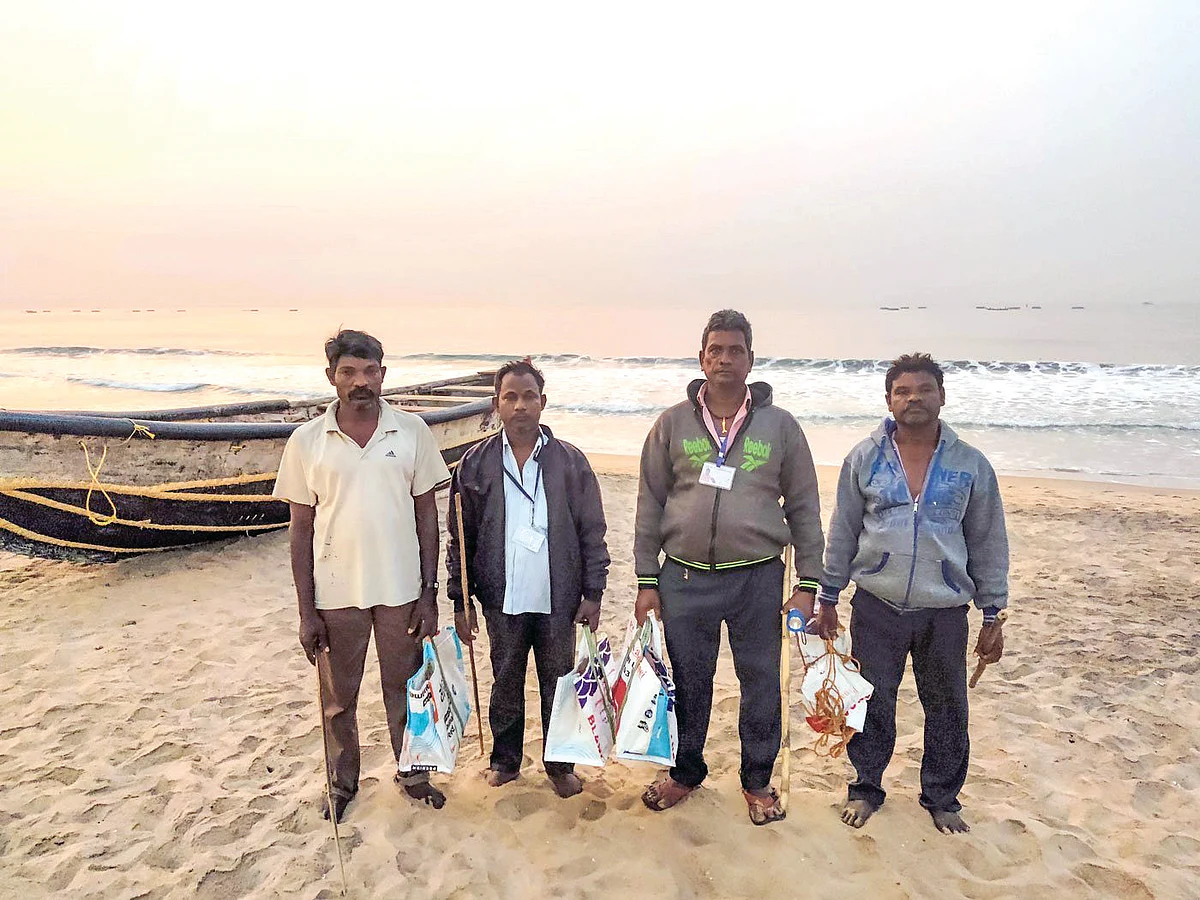Olive Ridley turtle: Survival of the littlest
Fishermen and migrant workers in Visakhapatnam are rescuing the endangered turtle—one egg at a time

It is 3.00 a.m. on a beach in eastern India. Ramolu Lakshmayya is using a flashlight to look for Olive Ridley turtle eggs. Armed with a long wooden stick and a bucket, he slowly traverses the sandy path between his home in Jalaripeta and Ramakrishna or RK Beach as it is popularly called.
Female Olive Ridley turtles come ashore to lay their eggs and Visakhapatnam’s sandy beaches with sloping shores make it an ideal nesting place; they have been spotted here since the early 1980s. However, a few kilometres north, the Odisha coast has the largest mass nesting sites in the country. The female turtles release 100–150 eggs at a time, burying them deep in sand pits.
“When the sand feels loose, it suggests that the mother turtle has laid her eggs here,” explains Lakshmayya, carefully probing the damp sand with the stick. Accompanying Lakshmayya are Karri Jallibabu, Puttiyapana Yerranna, and Pulla Polarao, fishermen from the Jalari community (listed under Other Backward Classes in Andhra Pradesh).
In 2023 they took up part-time work as guards with the Andhra Pradesh Forest Department (APFD) as part of an effort to conserve Olive Ridley turtle eggs under the Marine Turtle Conservation Project.
Olive Ridley turtles (Lepidochelys olivacea) have been categorised as a ‘Vulnerable Species’ on the International Union for Conservation of Nature’s (IUCN) Red List. They are protected under Schedule I of the Indian Wildlife (Protection) Act, 1972 (amended 1991).
Turtles are at risk because of several factors like coastal destruction, “especially at the nesting habitats in the name of development as well as loss of marine habitats due to climate change”, says Yagnapathy Adari, a project scientist at Kambalakonda Wildlife Sanctuary in Visakhapatnam. Sea turtles are also hunted for their meat and eggs.

“No matter how deep the mother buries the eggs, it is possible to find them. People may step on them, or worse, dogs may claw them out,” says Lakshmayya, emphasising the need to protect the eggs. “In the hatchery they are safe,” adds the 32-year-old.
Olive Ridleys are the smallest sea turtle species and get their name from their olive-green shell. Guards like Lakshmayya are critical to their survival.
They are recruited to search for turtle eggs and keep them in a hatchery, releasing them back into the sea once they hatch. The hatchery on RK Beach is one of four in Andhra Pradesh—Sagar Nagar, Pedanagamayyapalem and Chepala Uppada are the others.
At the Sagar Nagar hatchery, not all guards are fishermen; some are migrant workers who have taken up this part-time work for extra income. Raghu is a driver who picked up the job to help pay for his living expenses. A migrant from Srikakulam, Raghu moved to Visakhapatnam when he was 22 years old. He doesn’t own a vehicle but works as a driver and earns Rs 7,000 a month.
Taking up this part-time work has helped: “I am able to send back Rs 5,000–6,000 to my parents at home now.”
From December to May every year, guards cover a distance of 7–8 kilometres along RK Beach, stopping every few minutes to look for eggs. The nesting season for Olive Ridley turtles in India is usually from November to May, but the maximum number of eggs are found in February and March.

“Sometimes we spot the mother’s footprints; on rare occasions we catch a glimpse of the mother [turtle] herself,” says Jallibabu.
Once the eggs are found, they are carefully placed in bags, along with a handful of sand from the area. This sand will be used to rebury the eggs at the hatchery. They record the number of eggs, the date of their discovery and the estimated date of hatching, which they attach to a stick and place it near the burial spot. This helps keep track of the hatching timeline. The incubation period for the eggs is usually 45–65 days.
The guards remain stationed at the hatchery until 9.00 a.m. before setting sail into the sea for their main source of income—fishing. They get paid Rs 10,000 per month from December to May for their conservation work. The amount was Rs 5,000 till the last nesting cycle in 2021–22.
“The money I get for helping out the turtle babies has come in handy,” adds Jallibabu.
Lakshmayya chimes in, “It will be really helpful during the annual 61-day fishing ban during the breeding season which is from mid-April to mid-June.” However the guards hadn’t received their payment for this period. When PARI met them in June, they had only received their dues for the first three months: December, January and February.
During the ban, they have little to no income. “We usually take up other jobs at construction sites, etc. I just hope to receive the remaining amount soon,” Lakshmayya had said in June.
While a few were paid in August, the rest received their dues only in September—months after the fishing ban had ended.
Raghu says the favourite part of his job begins after the turtles hatch. The guards gently place them in a butta (basket) and release them into the sea at the beach.
“They dig out of their sand quickly and have the tiniest feet. They take small quick steps and don’t stop until they reach the ocean,” he says. “Then the waves carry the babies away.”
The last set of eggs hatched in June this year. According to the APFD, all four hatcheries, with 21 guards, collected 46,754 eggs and released 37,630 hatchlings into the ocean. And 5,655 eggs did not hatch.
“Many eggs were damaged during heavy rains in March 2023. It was really sad. When some hatchlings came out in May, they had broken shells,” says Lakshmayya.
Adari explains that the turtles imprint the geological location of their birth. Female turtles return to the same beach where they were born to lay their eggs after they reach sexual maturity at 5 years.
“I am happy to be a part of this. I understand the turtle’s eggs are sensitive and need protection,” Lakshmayya says, looking forward to the next nesting cycle.
(Courtesy: People’s Archive of Rural India (PARI). This story is supported by a grant from Rang De)
Follow us on: Facebook, Twitter, Google News, Instagram
Join our official telegram channel (@nationalherald) and stay updated with the latest headlines
